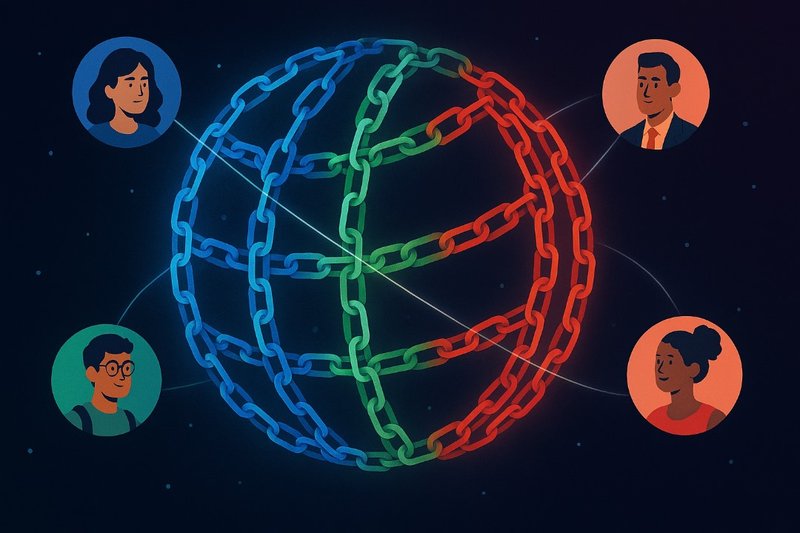🔍 Understanding Blockchain Beyond Crypto
When most people hear the word blockchain, they immediately think of Bitcoin, Ethereum, or cryptocurrency in general. But blockchain is far more than digital coins—it’s a foundational technology reshaping how the world operates. From how we store health records to how we vote and transfer assets, blockchain is becoming the invisible engine behind the next digital revolution.
🧠 What Exactly Is Blockchain?
Blockchain is a decentralized, distributed digital ledger that records transactions across a network of computers. Once data is recorded in a block and added to the chain, it’s nearly impossible to change—making it incredibly secure and transparent.
Unlike traditional centralized databases controlled by a single entity (like a bank or government), blockchain runs on peer-to-peer networks where every participant (or node) has access to the same data. This eliminates the need for intermediaries and reduces the risk of fraud or tampering.
🌍 Real-World Applications of Blockchain in 2025
Blockchain is no longer theoretical or exclusive to cryptocurrency projects. It’s powering real, measurable innovation across various sectors:
💰 1. Finance & Banking
-
Faster Cross-Border Payments: Blockchain enables instant, low-cost international transfers without going through multiple banks or payment processors.
-
DeFi (Decentralized Finance): Users can access financial services like lending, borrowing, and trading without a bank. This promotes financial inclusion, especially in unbanked regions.
-
Tokenized Assets: Real estate, company shares, and even art are now being tokenized and traded securely on blockchain platforms.
🏥 2. Healthcare
-
Secure Medical Records: Patients can control their own health data, which is stored on a tamper-proof blockchain. Doctors can access accurate records instantly, saving time and improving care.
-
Drug Traceability: Blockchain helps track pharmaceuticals from production to distribution, combating counterfeit drugs and improving safety.
-
Medical Research: Researchers can share data securely across borders without privacy violations, speeding up innovation and treatments.
🏛️ 3. Government & Public Services
-
Digital Identity: Citizens can have a single, blockchain-based ID to access all government services—no more scattered documentation.
-
Voting Systems: Blockchain voting ensures transparency, prevents tampering, and can increase voter turnout with secure remote access.
-
Transparent Budgets: Public spending can be tracked in real-time by citizens, increasing trust and reducing corruption.
🏢 4. Supply Chain & Logistics
-
End-to-End Product Tracking: Blockchain records every step of a product’s journey—from the raw material source to the customer—creating a transparent and auditable trail.
-
Reduced Fraud and Theft: With smart contracts and immutable records, products are less likely to be counterfeited or stolen.
-
Efficiency Gains: Automated verification and settlement processes reduce delays and human error.
🏡 5. Real Estate & Land Ownership
-
Fraud-Free Property Transactions: Smart contracts can execute secure and transparent real estate deals without middlemen.
-
Clear Land Ownership Records: Governments and communities can maintain land titles on blockchain, reducing disputes and illegal claims.
-
Global Market Access: Tokenized property allows people to invest in real estate anywhere in the world, in fractions.
📚 6. Education & Certification
-
Tamper-Proof Certificates: Academic records and professional certifications can be issued on the blockchain—verifiable by employers anywhere, instantly.
-
Lifelong Learning Records: Individuals can keep a single, unified, digital portfolio of all their learning achievements.
-
Global Recognition: Degrees and certifications from one country can be verified and trusted in another.
⚙️ 7. The Creator Economy & Digital Rights
-
NFTs and Copyrights: Artists, musicians, and creators can tokenize their work, ensure authenticity, and receive royalties automatically.
-
Decentralized Publishing: Writers and content creators can distribute work directly to audiences without platform restrictions or heavy fees.
-
True Ownership: Blockchain empowers creators to own, license, and monetize their content on their own terms.
🔐 The Role of Smart Contracts
At the heart of many blockchain applications are smart contracts—self-executing agreements where the terms are coded into the blockchain. These contracts remove the need for lawyers or third-party enforcement.
Smart contracts are:
-
Transparent – All parties can verify the terms.
-
Trustless – They don’t require trust because the code executes automatically.
-
Immutable – Once deployed, they can’t be altered without consensus.
They’re already being used for:
-
Insurance claims
-
Automated loan repayments
-
Royalty distribution
-
Escrow services
🌐 Web3 and the Decentralized Internet
Blockchain is the foundation of Web3, the next phase of the internet. Unlike Web2 (which relies on centralized platforms like Google or Facebook), Web3 is:
-
User-owned: Individuals have control over their data, identity, and content.
-
Permissionless: Anyone can participate, without gatekeepers.
-
Incentivized: Users are rewarded for contributing to networks and communities.
Blockchain allows for a more open, secure, and equitable internet, where power shifts from corporations to the people.
📈 Challenges and Limitations
While blockchain is powerful, it’s not perfect. There are hurdles to overcome:
-
Scalability: Many blockchains still struggle to handle large volumes of data and users.
-
Energy Consumption: Some networks (like Bitcoin) use high amounts of energy, though newer models (like proof-of-stake) are more efficient.
-
Regulation: Global laws are still catching up to blockchain’s speed and decentralization.
-
User Experience: For mass adoption, blockchain platforms must become more intuitive and user-friendly.
🔮 The Future Is Decentralized
The blockchain movement is not just about technology—it’s about reshaping power structures. It’s about giving people control over their identity, data, assets, and opportunities. Whether you're a student, entrepreneur, healthcare worker, artist, or policymaker, blockchain has something to offer you.
2025 is proving to be a breakthrough year. Projects like OroBit are leveraging blockchain not just to store value, but to tokenize real-world assets, expand financial access, and connect people to global opportunities.
As awareness grows and innovation continues, blockchain is on track to become as fundamental as the internet itself—but this time, with people at the center.
🚀 Whether you’re new to blockchain or already building in Web3, this is your time to engage, learn, and lead.
The future is no longer coming—it’s already being built. And blockchain is laying the foundation.
💬 Join the Conversation
As blockchain continues to reshape industries beyond cryptocurrency, the question becomes:
Should governments and global institutions embrace blockchain fully, or should decentralization remain in the hands of the people?
-
Is mass adoption only possible through regulation, or will that defeat the purpose of decentralization?
-
Can blockchain truly protect user freedom while still complying with global financial laws?
We’d love to hear your perspective.
👇 What do you think? Drop your thoughts in the comments and let’s discuss.




Comments (0)
Leave a Comment
No comments yet. Be the first to comment!